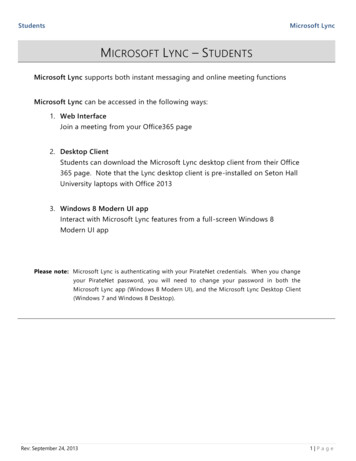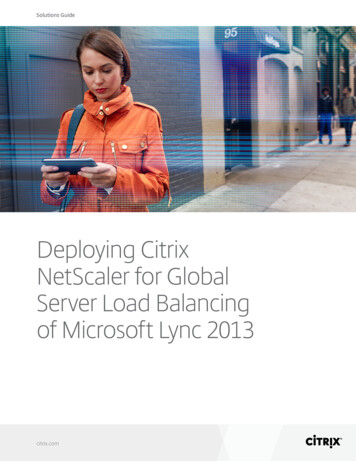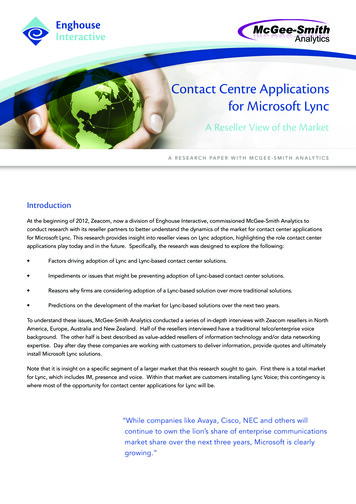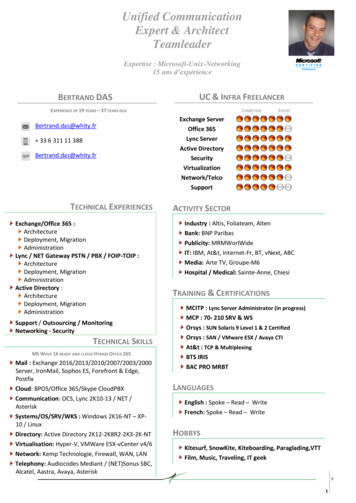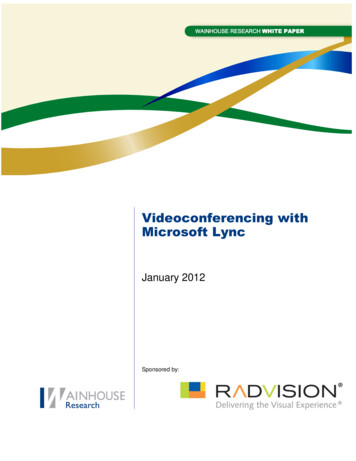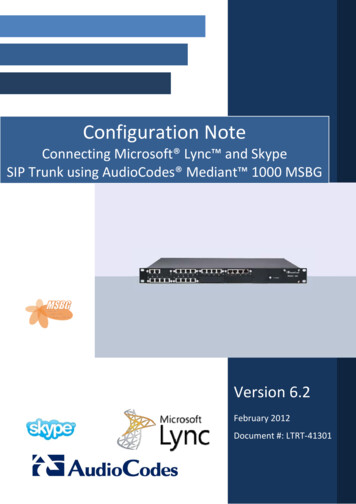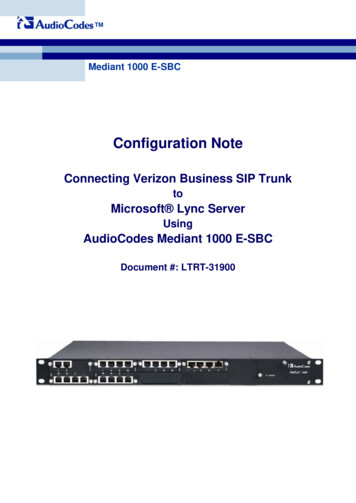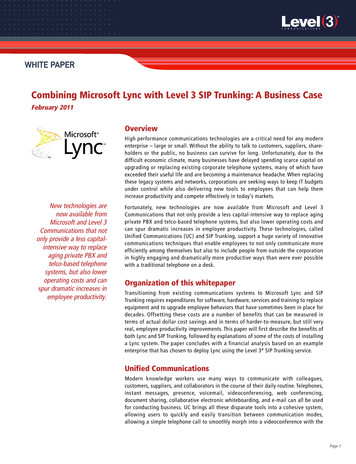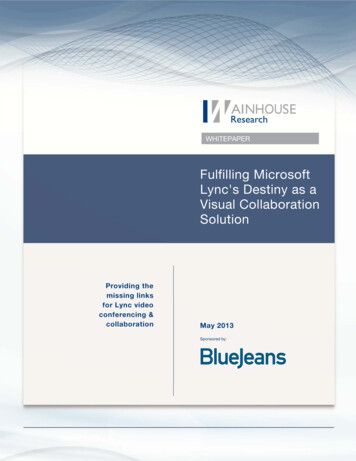
Transcription
WHITEPAPERFulfilling MicrosoftLync's Destiny as aVisual CollaborationSolutionProviding themissing linksfor Lync videoconferencing &collaborationMay 2013Sponsored by:Copyright 2013 Wainhouse Research, LLCPage 1
IntroductionMany enterprises today are considering a unified communications (UC) platform as the foundation for awide-scale rollout of personal video conferencing capabilities. Personal video conferencing promises togive PC-, Macintosh-, smartphone-, and tablet-enabled information workers the ability to connect withcolleagues, customers, and partners in a more direct, intimate, and efficient manner, while the UCconnection promises anywhere, anytime click-to-call convenience with an IT-friendly architecture.One of the leading platforms, if not THE leading platform, for enterprise deployments of UC is MicrosoftLync. Microsoft’s current product is Lync 2013, the result of at least four major Microsoft UC softwareupgrades that stretch back over a decade beginning with Live Communications Server and OfficeCommunications Server.Microsoft's strategy with Lync appears to have been based on a long term evolution that began withminimal native voice and video capabilities and a reliance on third party "partners" to bridge the gaps.Over time however, Microsoft has gradually filled in the missing pieces, particularly with respect toaudio, telephony, and video, thereby forcing independent partners either to a higher functionalityground or moving them off the OCS-Lync reservation altogether. In this vein, Lync 2013 introduced anumber of video conferencing capabilities that have historically been relegated to dedicated systemsand services, while delivering several video conferencing features that have never before been available,including support for scalable video coding (SVC) and continuous presence multipoint displays via agallery view. Nevertheless, enterprises today still face several significant challenges when the goal is touse Lync as the mainstay of their visual communications deployment.Microsoft Lync OverviewMicrosoft Lync is a unified communications platform that provides a consistent, single, unified-clientexperience for presence, instant messaging, persistent chat, voice, video, and data sharing. Lync isavailable as both a product that can be installed on the enterprise network, and as a service dubbedOffice 365. The Lync Web App allows PC and Mac users to join a Lync Meeting from within an HTML5based browser, and delivers a full Lync meeting experience, including multiparty HD video, voice over IP,instant messaging, desktop application, and PowerPoint sharing. Lync clients are also available for avariety of mobile hardware devices, including phones and tablets. Federation capabilities extend Lynccommunications to partners, suppliers, and customers who are also using Lync. In short, Lync simplifiesthe video conferencing user's experience by incorporating video into the unified client so that schedulinga meeting with video or escalating to video spontaneously is seamless and easy.Microsoft Lync Market Reality - 2013While Unified Communications (UC) solutions in general and Microsoft Lync in particular hold greatpromise for simplifying and unifying the enterprise communications experience, research results suggestthat the deployments today are very limited in both depth and breadth. A 2012 Wainhouse Researchworldwide survey of enterprise UC users asked about UC features that were deployed to more than 50%Copyright 2013 Wainhouse Research, LLCPage 2
of the user's organization. The results show that UC is still used primarily for presence and instantmessaging (IM). In fact, IM was the only feature that more than 40% of the survey respondents put inthis category (deployed to more than 50%).UC Features by 50% of the OrganizationInstant messagingP2P App sharingP2P audioAudio conferencingP2P videoWeb conferencingVideo conferencingPBXB2B FederationMobile integrationIntegration with room videoContact center integrationCustom integration0%10%20%30%40%50%60%70%Figure 1 Source; Wainhouse Research 2012 survey of enterprise UC usersFor deployments to 50% of the workforce, only 25% of respondents claimed that their UC solution wasbeing used for video conferencing, and only 15% answered that their room video systems wereintegrated with their UC platform. Clearly, the actual benefits realized by UC investments are far lowerthan the potential benefits.In other Wainhouse Research studies conducted in both 2012 and 2013, video conferencing channelpartners were asked about their customers' interest in integrating video conferencing with otherenterprise systems. For integrating video with a UC platform; the "high interest" level rose from 17% to28% while the "no interest" category fell from 19% to just 3%. Integrating with UC in all cases had ahigher level of interest than integrating with telephony. These results are consistent with otheranecdotal data suggesting that many large and small enterprises are looking to bring the videoconferencing user experience into the UC fold. These results are also consistent with Microsoft's recentintroduction of the Lync Room System reference architecture, a move designed to bring Lync into theenterprise conference room directly with support from established AV channel partners.Copyright 2013 Wainhouse Research, LLCPage 3
Interest in Integrating Video No Interest30%Medium20%10%0%14%11%17%Hi Interest28%10%5%Figure 2 Source; Wainhouse Research 2012 survey of video conferencing channel partnersCloud-based services are very much on customers' minds today. The buzz around "cloud" has causedmany IT and UC managers to think about the future of hardware- and software-based solutions and thetradeoffs between hosted and CPE solutions. Much of the industry seems to be in transition mode - infact 25-35% of all respondents in our end user UC survey indicate they are considering hosted servicesfor those UC components that are currently deployed as a CEPE solution. Our data shows that all of theUC communication functions are deployed in a variety of insourced and outsourced support strategies.Web ConferencingAudio ConferencingContact CenterShared WorkspaceVideo ConferencingIM/presenceEmailTelephony ure 3 Source; Wainhouse Research 2012 survey of enterprise UC usersCopyright 2013 Wainhouse Research, LLCPage 4
Lync 2013 Video CapabilitiesLync has long supported some form of visual communications. Perhaps the two most notableenhancements in Lync Server 2013 are 1) support for H.264 scalable video coding (SVC), an internationalstandard the details of which are beyond the scope of this document, but a development that couldmake future interoperability with Lync much easier; and 2) a form of continuous presence for multipointvideo calls (more than two participants) in which images from more than just the active speaker aredisplayed on a participant's screen. Microsoft's "Gallery View" displays a strip of up to five remote videowindows (the five most recent speakers) rather than the traditional "Hollywood Squares" approach.Pictures, if available, are displayed for all other participants in the second row. People are movedautomatically between the first row of video and the second row of still photos when they speak. OtherLync 2013 video capabilities include: A participant can check out his or her self-view before entering the conference. The video of the current speaker is highlighted with a blue bar below his or her tile in the toprow. The video portion of the display can be shrunk to give more room to the presentation. Or thevideo portion can be eliminated entirely. The Polycom CX5000 is still supported and provides a panoramic view of a conference room,filling a second row on the display. The presenter's video can be locked on while all other videos are turned off. The meeting host can prevent any attendee from starting video. Participants can ‘pin’ one or more video feeds to their galleryFigure 4 Video conference with Lync 2013Copyright 2013 Wainhouse Research, LLCPage 5
Lync for Enterprise Video Conferencing: Five ChallengesDespite the impressive evolution of Lync's communications capabilities, the UC platform is still stuck in apilot phase with many customers, largely due to the challenges that come with enabling an enterprise’sLAN / WAN to support the demands of a mass deployment of desktop video. Enterprises today still facefive significant challenges when deploying Lync as the mainstream solution for their video conferencingneeds. Overcoming these challenges will help Lync become the ubiquitous solution empoweringinformation workers, speeding decision making, and enabling the next generation of B2B and B2Ccommunications.1. Interoperability with Room Video Conferencing SystemsWell over 1.5M conference room video conferencing systems remain in use today. These devices almostexclusively support the ITU's H.323 protocol and/or the IETF's SIP protocol for signaling as well as H.263and H.264 for video compression/decompression. While interoperability between the growing numberof desktop Lync video users and the installed base of conference room systems has long been a marketdemand, such interoperability remains a challenge. To solve this problem, several vendors haveintroduced Lync gateways. Gateways provide the signaling and protocol conversions needed to bridgeLync with third party devices, but introduce cost, complexity, and scalability challenges. Other vendorshave enhanced their SIP support so that a room system can register to a Lync server, and/or addedsupport for Lync's proprietary codecs to support higher quality images, but these capabilities apply toonly their latest products. The end result is that Lync-to-room-system interoperability is complicated,unreliable, and of very limited practical use today.Microsoft itself took a new approach to the interoperability challenge in February, 2013 when thecompany introduced the aforementioned Lync Room System (LRS). LRS is actually a detailed referencearchitecture rather than a physical product from Microsoft. The LRS is a locked-down PC with adedicated Windows operating system and Lync installation. Microsoft’s intent is to bring the familiarLync user interface and experience into the conference room on a system with high quality audio-videoperipherals. Systems based on the LRS architecture have been introduced by multiple vendors. Thebottom line on LRS is that there is no interoperability problem with Lync desktops and mobile usersbecause the room system itself is a Lync system.2. Interoperability with Non-Lync Desktops (and mobile devices)Lync is Microsoft's UC platform for business, while Skype has been positioned as the UC platform forconsumers. While Microsoft has promised Lync/Skype federation for mid-2013, the initialcapabilities are limited to presence, IM, and voice across the two services. Video support is sometime in the future. Similarly, Cisco Jabber and numerous browser based video conferencing optionshave gained significant traction, especially in the SMB and consumer space. Being able to connectthose users to the Lync world remains a significant challenge.1 However, the ability to do so holdsenormous potential to link Lync and non-Lync users and to enable B2C communications.Copyright 2013 Wainhouse Research, LLCPage 6
3. Limited Multipoint CapabilitiesLync 2013 supports 1080p (1920x1080) and 720p (1280 x 720) high definition as well as VGA (640x480)resolution video for peer-to-peer and multipoint calls between Lync users. The resolution viewed byeach participant may differ however, depending on the video capabilities of each user’s respectivehardware. Resolution aside, Lync 2013 supports one basic continuous presence format – the GalleryView, showing up to 5 side-by-side taking heads. While this is certainly an improvement from Lync2010’s low resolution voice activated switching, it falls far short of the industry standard continuouspresence experience provided by most video bridge manufacturers.Multipoint capabilities have been available in the video conferencing industry for well over 20 years. Asa result, experienced users are accustomed to well-developed, feature rich multipoint capabilities,including the ability to switch between voice-activated and continuous presence modes, to speed matchand transcode between different codecs on different devices, and to see more than five participants in avideo meeting. Microsoft's own multipoint capabilities are limited to Lync endpoints or Lynccompatible room systems; customers who need to bring a non-compatible room system into amultipoint meeting with Lync or need to see more than five live video streams will need to deploy avideo bridge or bridging service from a third party. The selection of third party bridges that support Lyncis limited, however, and the devices remain costly.4. Limited Data Collaboration CompatibilityData collaboration is an important capability that turns a video conference into a visual collaborationsession. Screen sharing is very easy (one click interface) with Microsoft Lync and is one of Lync's strongpoints, provided all the endpoints are Lync endpoints. Screen sharing to or from a Lync endpoint fromany industry-standard videoconferencing system is not possible because Microsoft uses a proprietaryRDP data sharing protocol while the video conferencing industry uses either the ITU's H.239 or the IETF'sBFCP or both.5. Federation ComplexityLync federation enables users at company A to be able to view presence, send IMs, and place computerto-computer voice and video calls to Lync users at other institutions. Lync supports two key federationsecurity levels as follows:-Open Federation: Anyone running Lync can discover and federate with other Lync environmentsconfigured for Open Federation - this poses large security concerns for many customers.1Lync 2013 does include a plug-in-based Web Attendee app that allows non-Lync users to join a scheduled Lyncconference via audio/video/content sharing from standard browsers on Mac and Windows. The Lync mobile clientis also a/v enabled.Copyright 2013 Wainhouse Research, LLCPage 7
-Direct Federation: (also known as Allowed Partner Server federation) Users establish a series ofone-to-one relationships of allowed and blocked SIP domain names and federation servers anddo not allow for discovery of other federation partners. Each enterprise must share specificinformation in order to establish a federated connection. While this solves security concerns, itcan easily lead to the NSquared problem (N2) whereby enterprises find themselves establishingmultiple, individual connections to a large number of partners.Consider the situation where a company is working on a product development project that involvesexternal suppliers and agencies as well as internal resources in sales, marketing, and engineering. All ofthese resources need to communicate with client team members, and in addition, some of the partnersneed to collaborate with other partners. Lync allows for this type of multi-enterprise communication,but requires individual federated relationships, each of which needs to be configured properly andmanaged. For both sides of each federation connection shown in the diagram, a SIP domain nameneeds to be entered into the "trusted" layer. This process can quickly become overly burdensome.Contract SWDeveloperMaterialSupplier #1MaterialSupplier #2Ad AgencyPR AgencyContractManufacturerLaw FirmMarketingSalesEngineeringClient InternalFigure 5 Multiple Lync federations required for typical product development processWhile the actual process of federating – trusting a partner’s SIP domain – takes an IT administratorminutes, the workflow that many organizations implement around federation is often cumbersome, andforeign to most users. The reality is, the business unit holds the relationship with each partner – not theIT team. Therefore, the business unit needs to determine which IT resources to put together to tradeinformation, and some organizations attempt to add barriers of approval to ensure they don’t federatewith a competitor or other mistrusted entity – in all, this results in fewer federated relationships.Solution Spotlight - Blue Jeans NetworkBlue Jeans Network (BJN), the sponsor of this white paper, has taken a different view to the videoservices business. BJN offers not just a hosted video bridging solution based on internally developedsoftware running on industry-standard servers, but also a bridging solution intended to make videocalling frictionless:Copyright 2013 Wainhouse Research, LLCPage 8
Easy-to-useInteroperable with multiple protocolsFeature-rich, including support for data collaborationAffordable for companies of all sizesBJN developers began with a roadmap of how an enterprise would establish a video conferencingenvironment that begins with federation, continues on to support users' meeting scheduling needs,provides an easy way for professionals and consumers to join meetings no matter what endpoint orprotocol is selected (room, personal, or mobile), and finally delivers a superior AV experience. In theprocess, BJN addresses the five major challenges facing Lync video conferencing customers.1. Interoperability with Legacy Room Video Conferencing SystemsThe BJN bridging service connects Microsoft Lync clients with industry standard SIP and H.323-basedvideo systems from a variety of suppliers including Avaya, Cisco, LifeSize, and Polycom. The connectionis seamless. There are no settings to change, configurations to check, or registrations to complete. WithBlue Jeans, it is a simple matter to bring together Lync-based participants with teams meeting in largeand small conference rooms.Figure 6 Blue Jeans Network screen shot: Lync desktop with room system conferenceCopyright 2013 Wainhouse Research, LLCPage 9
2. Interoperability with Browsers and Other Popular Desktop/Mobile ClientsThe ability to include web browsers and other popular desktop/mobile client users, as well asstandards-based room systems, into meetings with Lync users is a game changer. Support for browsersand other non-Lync solutions enables B2B and B2C video communications for Lync-based workers inboth large and SMB enterprises.Interoperability with room systems, Cisco Jabber, a multitude of 3rd party desktop clients and Lync isalso supported by Blue Jeans' own browser-based client. This provides Lync users the ability to inviteanyone internal or external to the organization, regardless of what client they have installed, including"no-client at all" (in the case of a browser with plug-in) into a video meeting.Whether joining a Blue Jeans hosted meeting from a standards-based room system, a Lync client, abrowser, or via Cisco, Polycom, etc., Blue Jeans has simplified the "join meeting" process by providingemail invites that include detailed instructions, typically "click here to join," specific to each type ofconnection. Blue Jeans meetings between Lync and mobile users are often ad-hoc, unscheduled events,but the service also embraces scheduled meetings as well. Blue Jeans provides an Outlook add-in and aGoogle Chrome Extension that automatically add all the BJN contact details into the meeting invitation(email). At the appointed time, the user need only open his calendar event and "click to join."3. Scalable Multipoint CapabilitiesBlue Jeans supports up to 100 video participants per meeting and supports 3 layout options, includingthe traditional continuouspresence mode, with upto 9 of the most recentspeakers on screensimultaneously. Meetingscan include any mix ofany of the systemssupported by BJN,thereby bringingLync, Jabber, webbrowsers and roomsystems together in onerich video session. Themultipoint capabilities,combined with the easyto-connect paradigm ofBlue Jeans, make theservice a natural forbusiness collaborationFigure 7 Blue Jeans Network screen shot: multipoint video conferencesessions.Copyright 2013 Wainhouse Research, LLCPage 10
4. Rich, Two-way Data Collaboration CapabilitiesThe Blue Jeans service enables full two-way data sharing between Lync clients, browsers, otherdesktop/mobile clients, and industry standard video conferencing systems. The Blue Jeans bridgesupports all the native data sharing and audio/video codecs used by Lync, SIP, and H.323 systems and isable to support up to 1080p content sharing to/from any device, including the web-based browser andiOS / Android apps. Meetings are more productive with BJN because each participant can controlcontent sharing using the user interface with which he is most familiar.Figure 8 Blue Jeans Network screen shot: data collaborationFigure 9 Blue Jeans Network screen shot: data collaborationCopyright 2013 Wainhouse Research, LLCPage 11
5. One-Time FederationWith Blue Jeans, customers and any partners to whom they wish to connect over video, need federateonly once - to the Blue Jeans service. BJN then handles the directory and SIP domain changes needed toenable B2B media communications between enterprises. Federation to Blue Jeans maintains theprivacy of the enterprise since it does not expose Lync contact lists, presence or IM capabilities betweenenterprises. Blue Jeans resides in the middle as an exchange providing audio, video and content sharingcapabilities between the parties, while offering connectivity to any other enterprise federated to theBlue Jeans meet-me service.Contract SWDeveloperMaterialSupplier #1MaterialSupplier #2Ad AgencyPR AgencyBlue Jeans NetworkContractManufacturerLaw FirmMarketingSalesEngineeringClient InternalFigure 10 Simplified federation with Blue Jeans NetworkOther Blue Jeans BenefitsAs a hosted or "cloud" service offering, Blue Jeans offers significant benefits to video conferencing users.First of all, there is no capital investment required, no upfront costs. And as a service provider, BJN iscommitted to providing sufficient capacity where port availability is never an issue. A variety ofsubscription plans from unlimited-use site licenses, to virtual ports, minutes plans and named userlicenses, are available to meet user needs ranging from occasional to frequent. For some users, the costof a multi-user subscription plan will be less than the monthly maintenance cost of a video bridge. BJNusers never have to worry about software upgrades or hardware maintenance plans since the companyis committed to continuous innovation, feature enhancements, and support for the latest endpoints,algorithms, and protocols on its own software-based video infrastructure.Finally, Microsoft Lync is available as both an on-premises solution (CPE) as well as through a hostedservice from Microsoft (Office 365) and other conferencing service providers. Integrating betweenthese two is simple with Blue Jeans Network because Blue Jeans treats any Lync client, whether joining ameeting from a CPE deployment or from a hosted service as a discrete entity with full functionality andinteroperability. The major benefit for customers is that they will not need an on-premises Lync serverin order to provide full video capabilities to Office 365 users. In this sense, Blue Jeans provides Lync-toLync connectivity that even Microsoft does not yet support.Copyright 2013 Wainhouse Research, LLCPage 12
SummaryAs a video conferencing solution, Microsoft Lync 2013 brings many improvements over previousversions, but Lync presents no threat to today's room video conferencing systems. Leveraging its IM andpresence heritage, Lync is about making desktop-based meetings and presentations more productiveand interactive.As a desktop video conferencing and collaboration solution, however, Lync 2013 does remove some ofthe impetus customers may have felt in the past to augment Microsoft's UC solution with third partyvideo enhancements. Clearly, the need for a third party multipoint bridge is reduced based on therecent addition of continuous presence and H.264 support, if nothing else. And with HD support, now,more than ever, Lync customers may conclude that Lync video, while perhaps not quite as good as thesolutions available from the video conferencing specialists, is actually "good enough." But a closerexamination reveals that Lync still faces significant challenges in terms of interoperability, complexity,and multipoint functionality. Lync users will be well advised to look at a hosted video bridging andinteroperability service like that offered by Blue Jeans Network to fill in many of the functionality gaps.About Wainhouse ResearchWainhouse Research, www.wainhouse.com, is an independent market research firm that focuses on criticalissues in unified communications, visual collaboration, and rich media conferencing technologies andapplications. The company conducts multi-client and custom research studies, consults with end users onkey implementation issues, publishes white papers and market statistics, and delivers public and privateseminars as well as presentations at industry conferences. Wainhouse Research also publishes a freenewsletter, The Wainhouse Research Bulletin that covers all aspects of rich media enterprisecommunications.About the AuthorAndrew W. Davis is a researcher, analyst, and opinion leader in the field of collaboration and conferencing.He is a co-founder of Wainhouse Research and currently focuses on covering the video side of thecollaboration market as well as strategy consulting and new business development activities. A well-knownindustry guest speaker, Mr. Davis holds B.S. and M.S. degrees in engineering from Cornell University and aMasters of Business Administration from Harvard University. More about Andrew.About Blue Jeans NetworkBlue Jeans Network was founded in November 2009 with a passion to make video communications easy.Starting from the ground up, Blue Jeans was built as a cloud-based video collaboration service that enablespeople to connect with each other any time, any place and from any device. Blue Jeans Network extendshigh quality video communications beyond the traditional boundaries of specialized conference rooms andinto the mainstream, allowing individuals and employees throughout an enterprise to interact moreeffectively with each other, and with their customers, partners, suppliers, family, and friends. Blue JeansNetwork is a private company headquartered in Mountain View, California. For more informationvisit bluejeans.com or follow the company @BlueJeansNet .Copyright 2013 Wainhouse Research, LLCPage 13
Microsoft Lync Overview Microsoft Lync is a unified communications p latform that provides a consistent, single, unified-client experience for presence, instant messaging, persistent chat, voice, video, and data sharing. Lync is available as both a product that can be installed on the enterprise network, and as a service dubbed Office 365.

